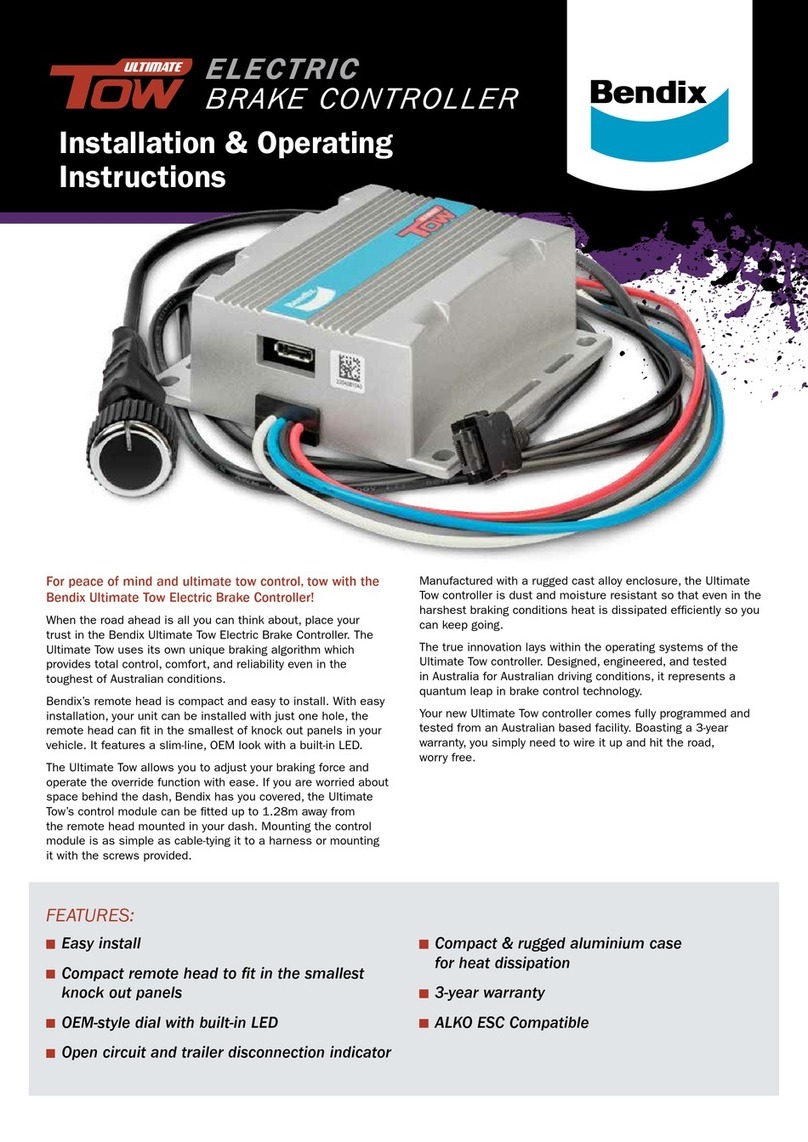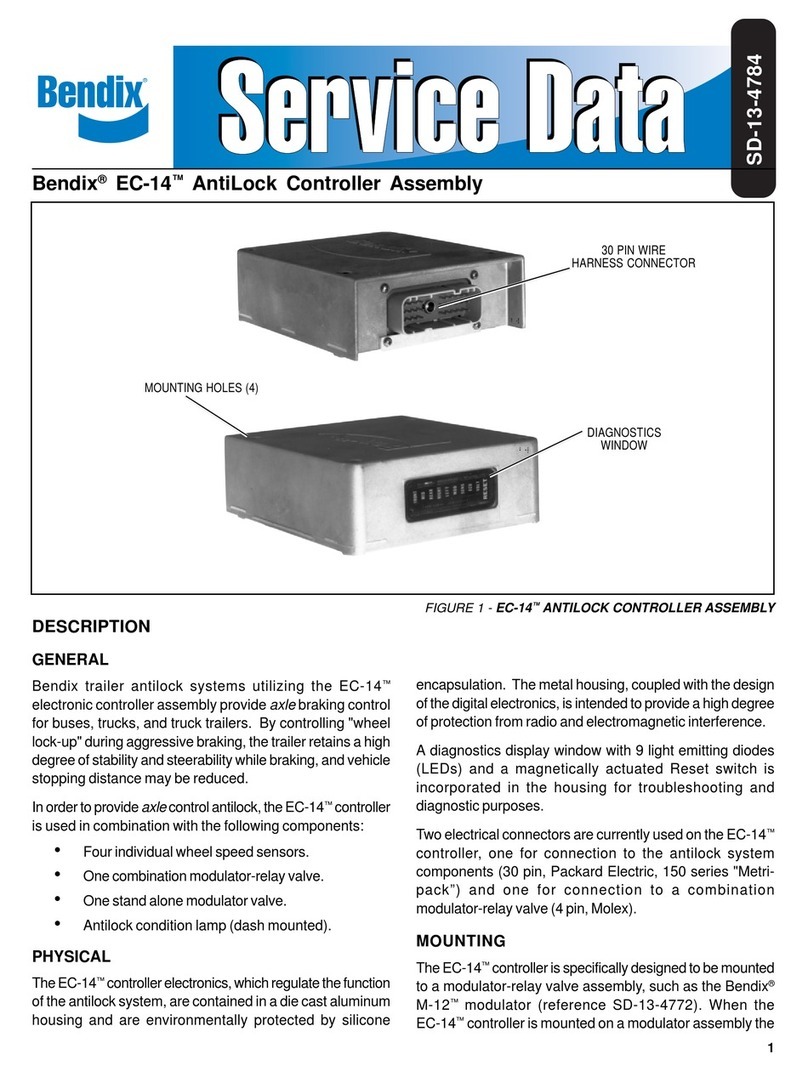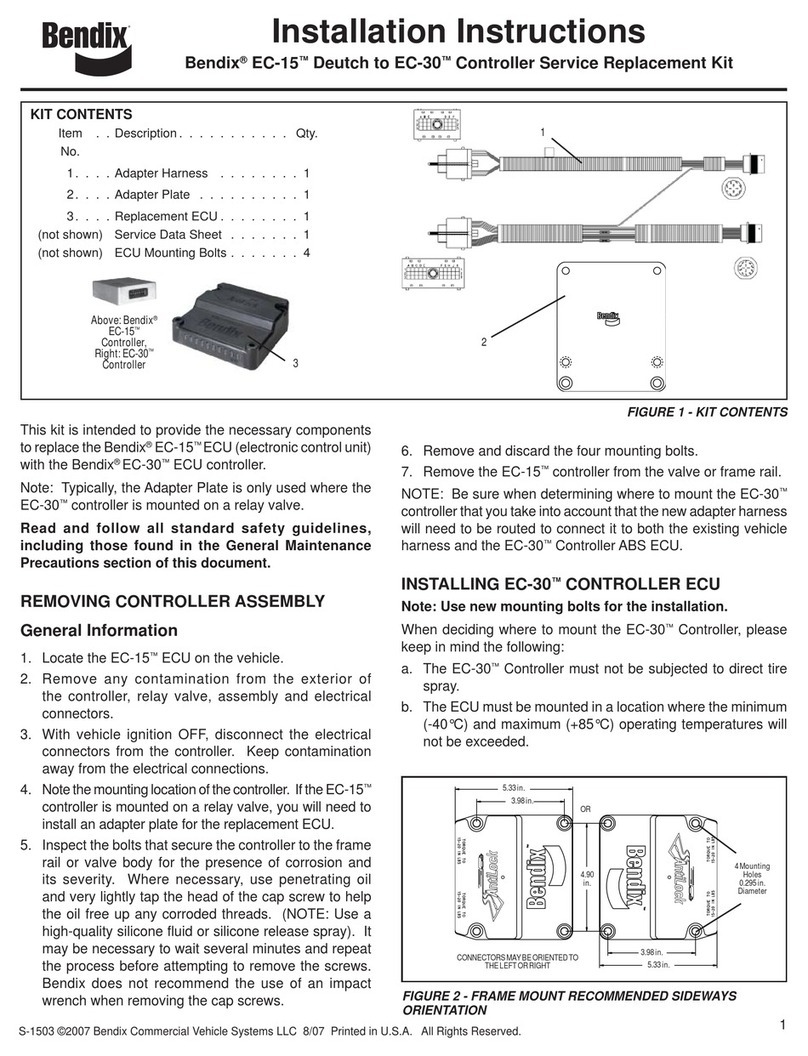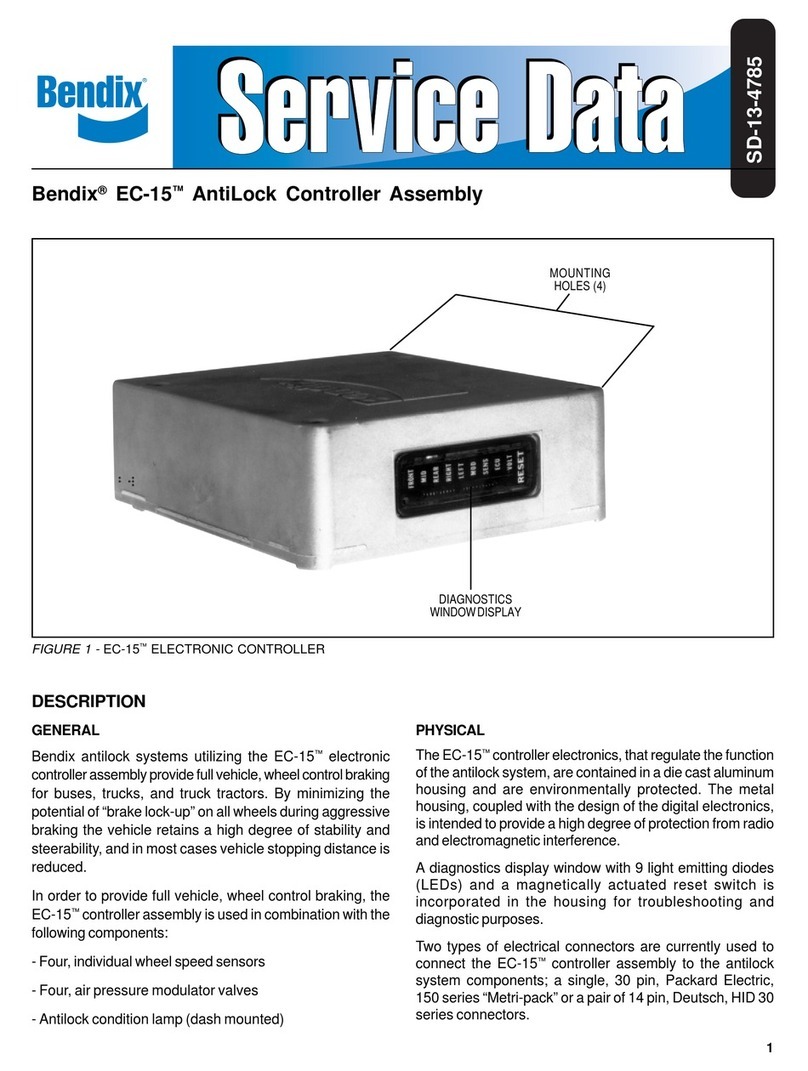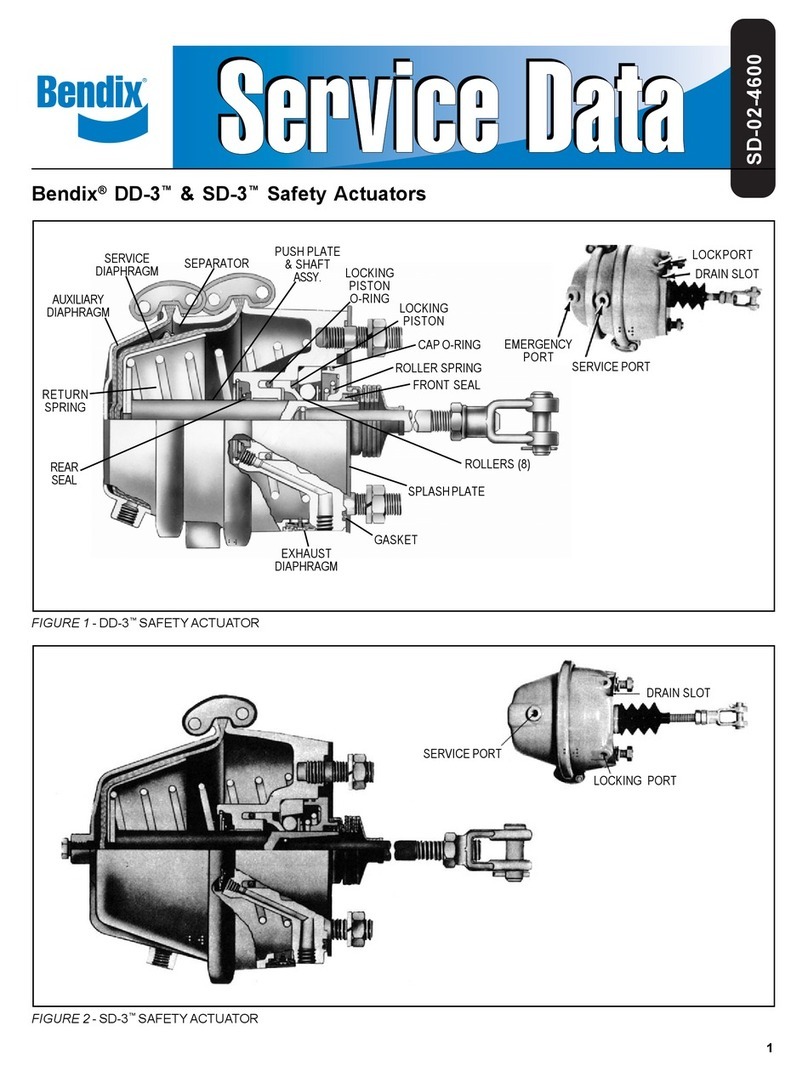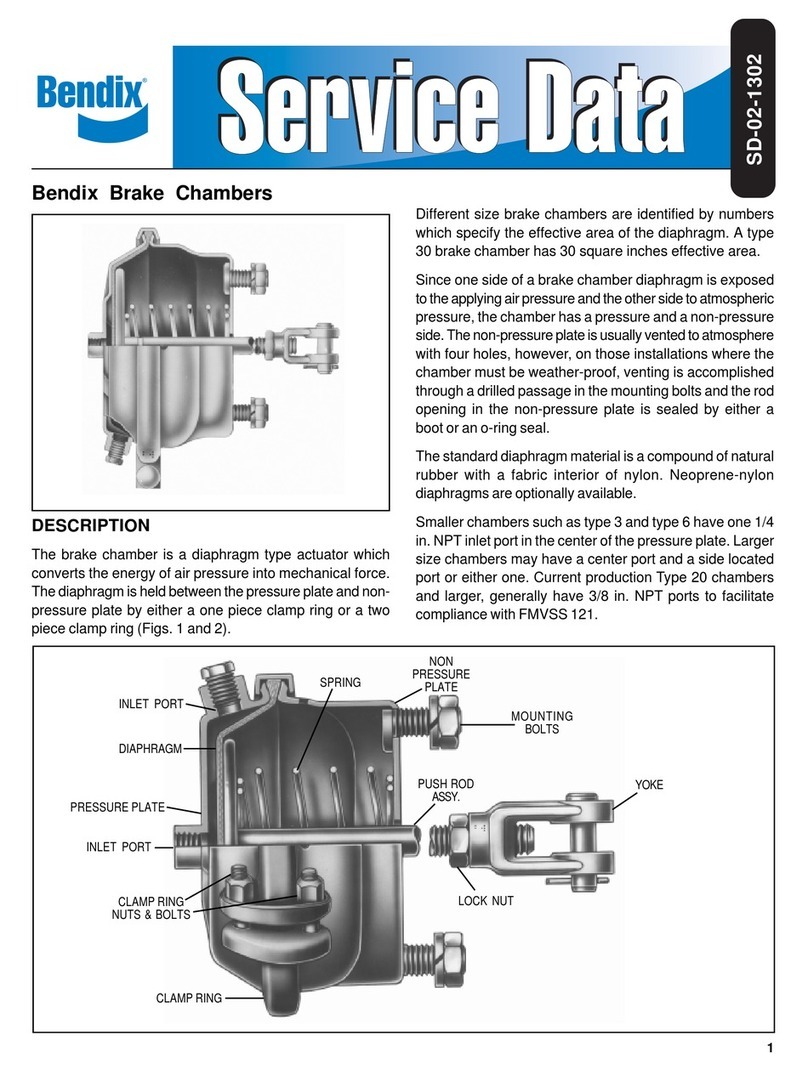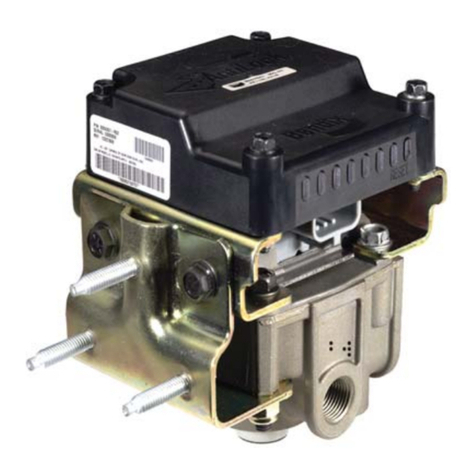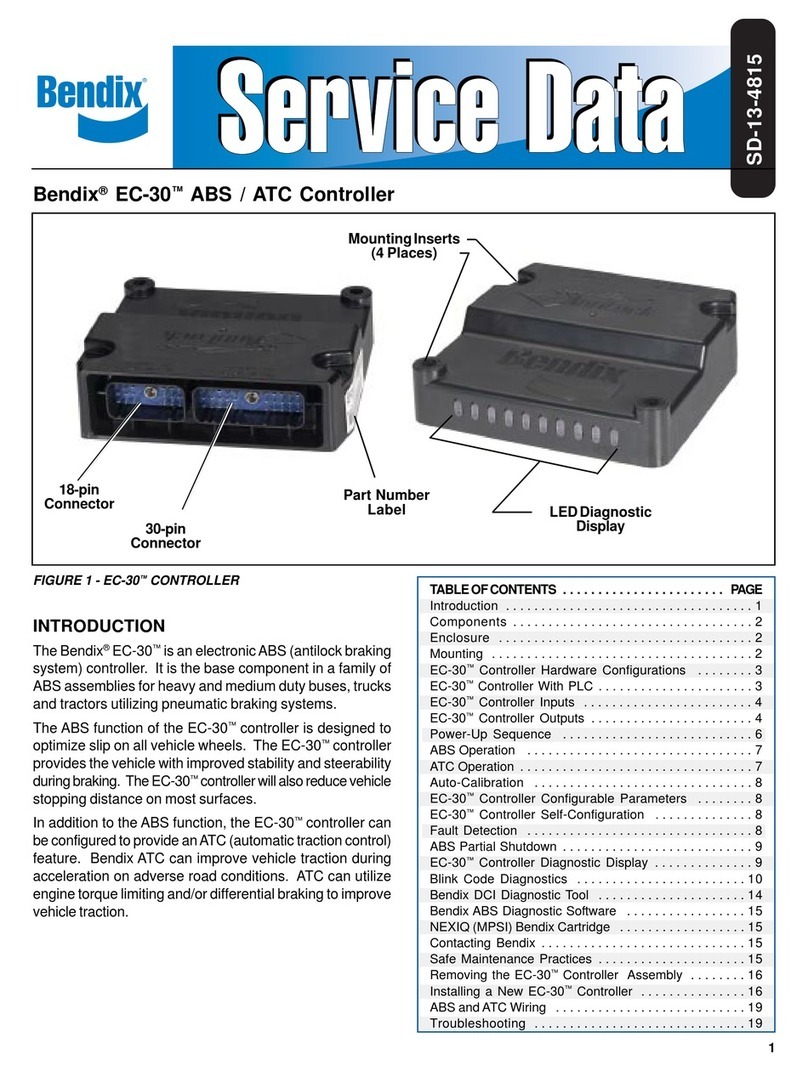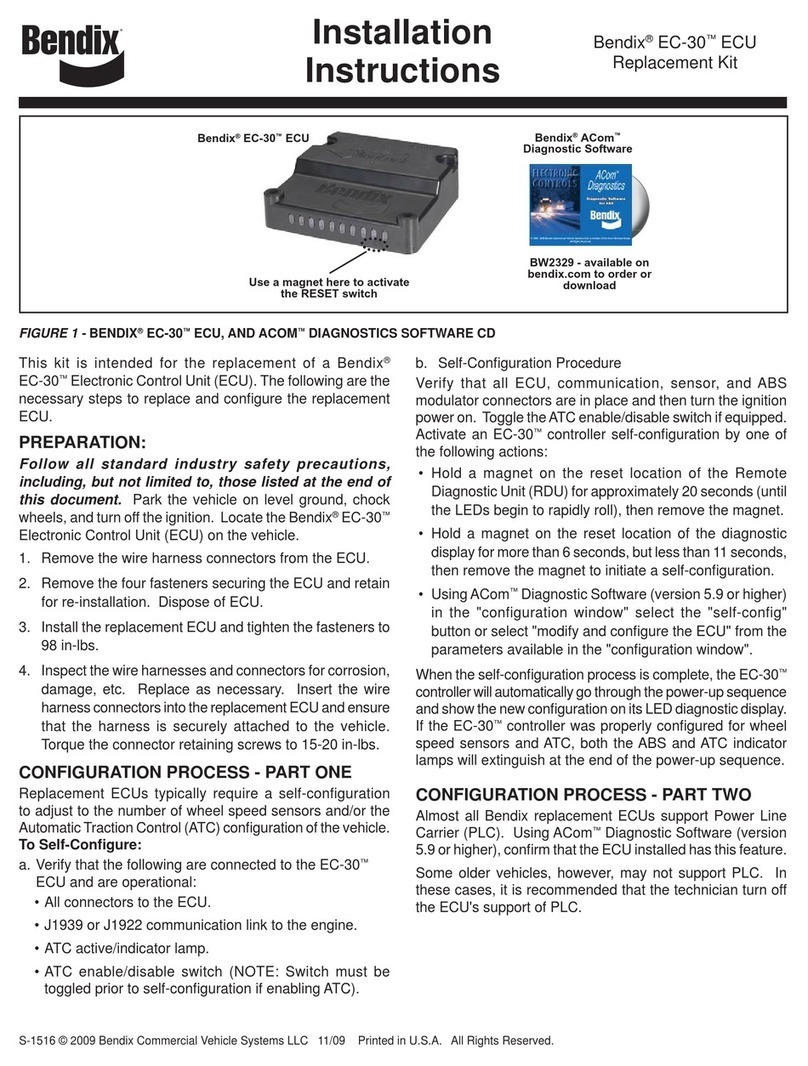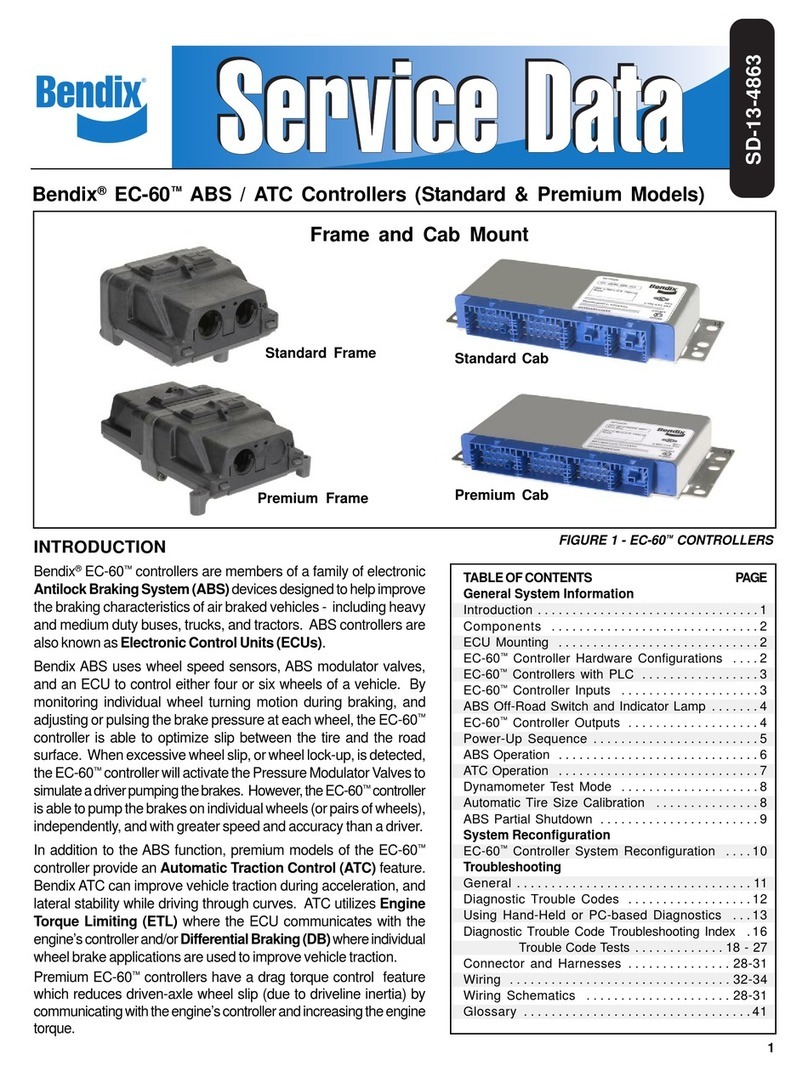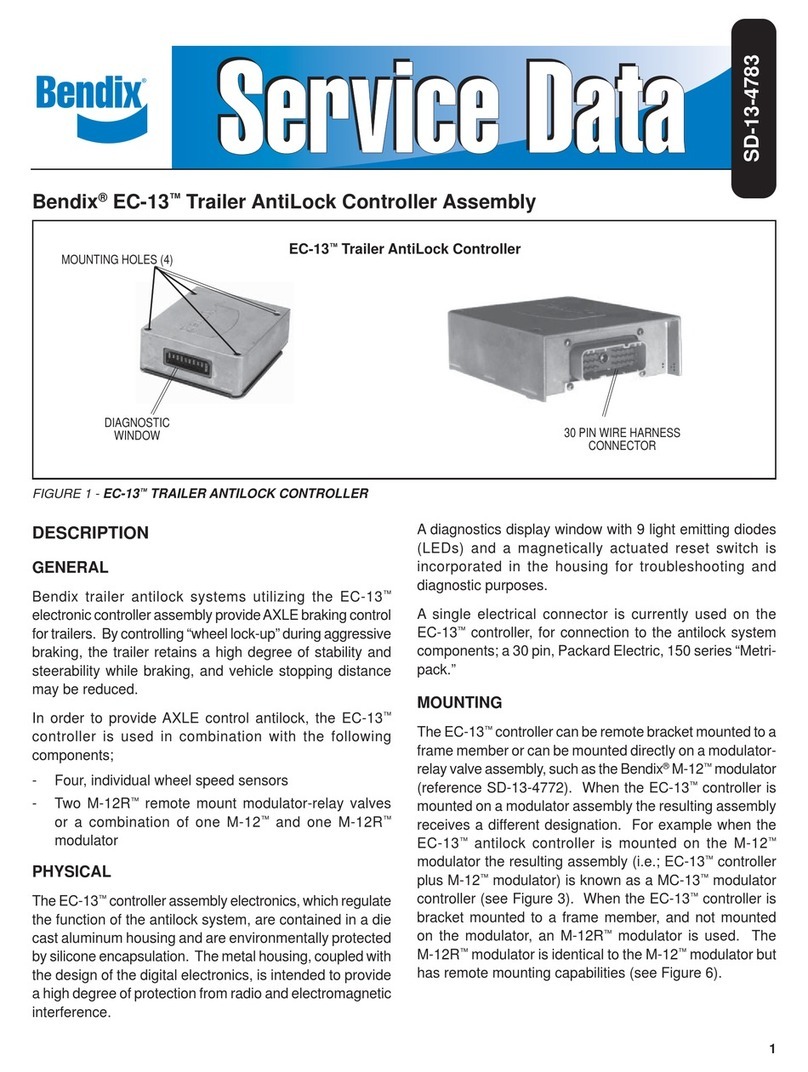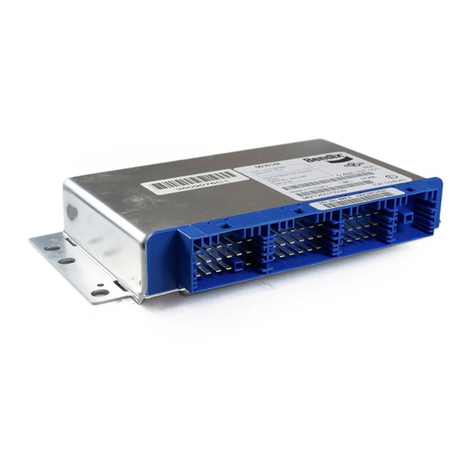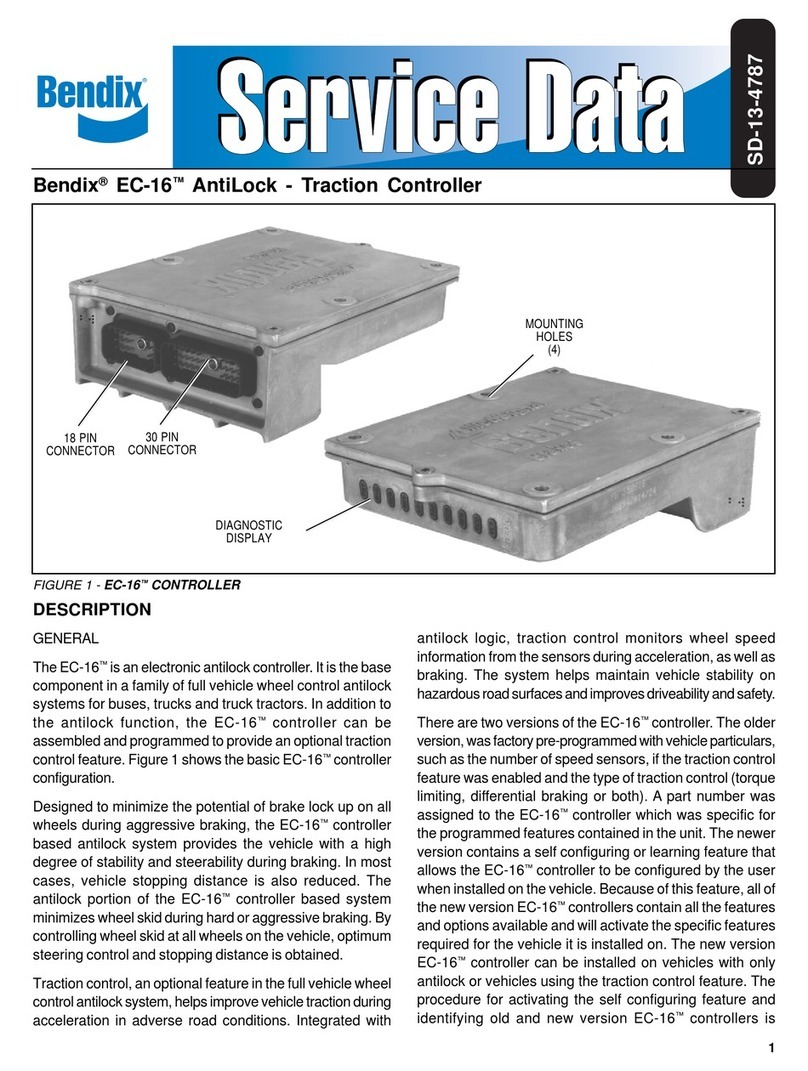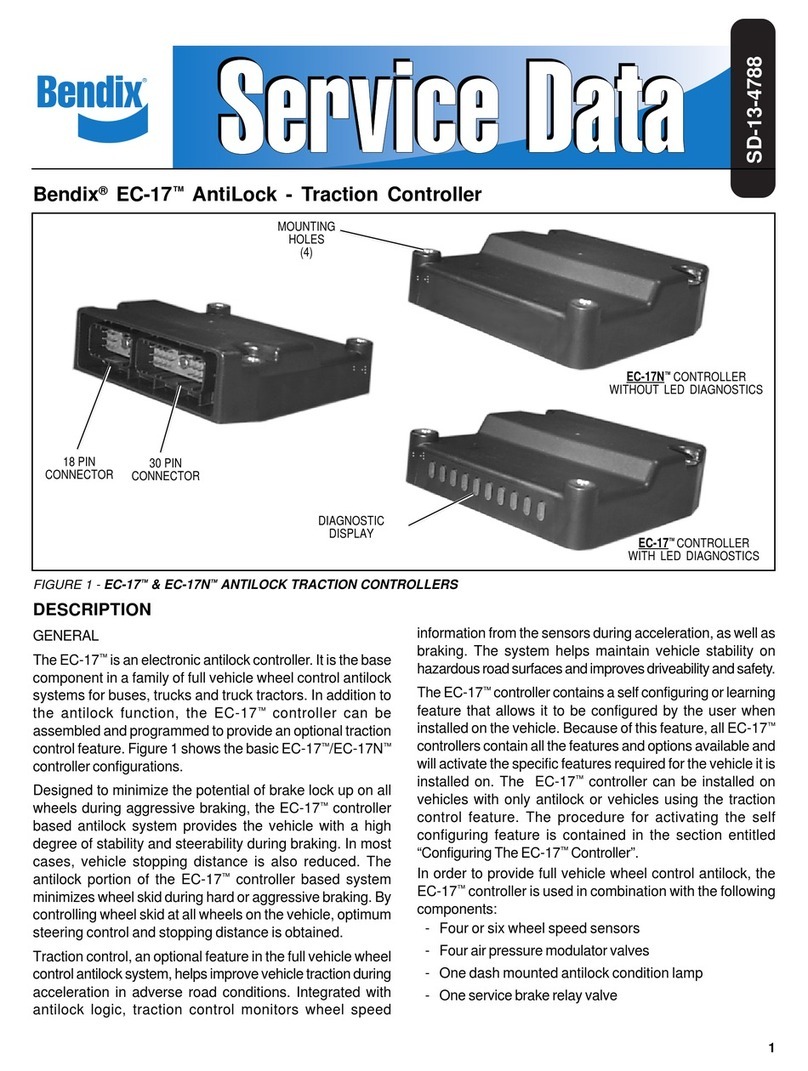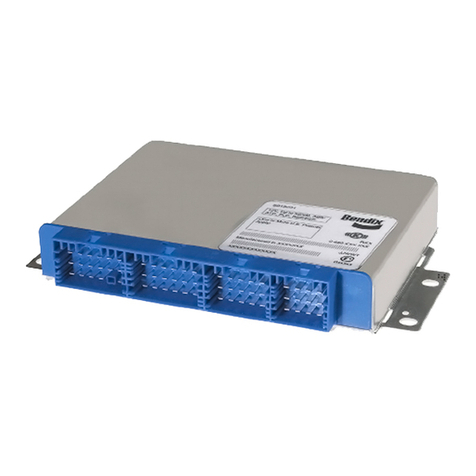
INSTRUCTIONS
ALWAYSUSEEXTREMECAUTIONWHENWORKINGON
ORAROUND VEHICLES.
START UP: Whenpowerisappliedtheantilockandtraction
dashwarninglampswillilluminateforaperiodof2.5seconds
while the electronic control unit (ECU) is performing a self
check, and “Chuff” test. If a trailer being towed has PLC,
the trailer dash lamp will illuminate for 2.5 seconds then
turn off unless a fault is indicated. The ABS and traction
control modulators will be energized during the Chuff test.
It is recommended during the initial start up that the brakes
be applied to audibly hear the modulators exhaust during
the “Chuff’ test.
SERVICE NEEDED: Whenan issue isdetectedat start up,
the dash lights will flash and remain illuminated. When a
dynamicwheelspeed issue is detected the dash lamps will
illuminateasearlyas10mph,indicatingawheelspeedissue.
The dash lamps notify the driver that all or part of theABS
function has been disengaged and standard air braking is
ineffect. TheECUwillautomaticallyreset most intermittent
codes (self healing). In most instances, if the intermittent
code has occurred more than five times the issue will be
latched and require a magnetic reset. The area of concern
will always be identified in the diagnostic display.
TRACTION FUNCTION: The ECU monitors wheel spin.
When a spin condition exist, the traction dash lamp will
blink continuously indicating the traction control system
is active. IF SERVICING THE VEHICLE DRIVE LINE,
TRACTIONSERVICEENABLE/DISABLESWITCHMUST
BE DISABLED.
(The traction dash lamp will be illuminated)
RESET: TheECUcanbemagneticallyresetbymomentarily
holdingamagnetagainst theRESETareaon thecontroller.
SELF CONFIGURING: During self configuring the ECU
will automatically determine the number of sensors and if
electronic engine equipped. The ECU will also determine if
the vehicle is traction equipped ONLY if the traction switch
is toggled prior to magnetically self configuring. Holding a
magnetagainsttheRESETarea for 30 seconds completes
self configuring.
BLINK CODE ACTIVATION: The ECU will provide blink
code diagnostics through the use of the blink code switch.
Detailsonactivefaults,faulthistory,ECUconfiguration,and
clearing of faults can be found in service data SD-13-4815.
Troubleshooting EC-30™Controller Antilock Systems with Optional Traction Control
ANTILOCK / TRACTION
CONTROLLER
(Ref. SD-13-4815)
EC-30™
CONTROLLER
DIAGNOSTIC
DISPLAY
1587 DIAGNOSTIC
CONNECTOR
ABS
ATC
M-30™
Modulator
DASH
LAMPS
TRACTION SERVICE Enable / Disable
(LOCATED IN DASH AREA)
When Servicing DRIVELINE
Disable TRACTION (Switch OFF)
VEHICLE
ENGINE MODULE
TYPICAL
FRONT
AXLE
Ty Wrap
Right
Angle
Sensor Mounting
Straight
Sensor
Clip
Exciter
Ring
Trailer ABS
Blink Code Switch
(Optional)
ANTILOCK
MODULATOR
ASSEMBLIES
WHEEL SPEED
SENSOR-CONNECTOR
TYPICAL
REAR AXLE
Resistance for WS-20™and WS-24™
wheel speed sensors across pins:
1500-2500 Ohms
(Ref. SD-13-4754 for WS-20™sensors)
(Ref. SD-13-4860 for WS-24™sensors)
Lap Top
Computer
J1708/J1587 (RP-1210) Hardware
InterfaceAdapter
Parallel
or Serial
Cable
PC Software
• ACom®Diagnostics
order BW2329 or
download from
www.bendix.com
M-32QR™
Modulator
M-32™Modulator
(Ref. SD-13-4830)
(Ref.
SD-13-4870)
M-30™Modulator M-32™& M-32QR™
Modulators
Hold To Source: C – B Read 3.5 to 5 Ohms Read 4.9 to 5.5 Ohms
Exhaust To Source: A– B Read 3.5 to 5 Ohms Read 4.9 to 5.5 Ohms
Exhaust To Hold: A– C Read 7.0 to 10 Ohms Read 9.8 to 11 Ohms
Source To Ground: B – No Continuity No Continuity
Toubleshooting Test
M-32™and M-32QR™
Modulator Twist-Lock (Bayonet)
and Threaded (Metric) Connectors
Exhaust A
Source B
Hold C
Exhaust
A
Source
BHold
C
Connector
M-30™and M-32™
Modulator Packard
Connector
Hand Held Tools
• Brake-Link™* 5010749
• Application card available from
NEXIQ™*, SPX™*, Kent-Moore™*.
*Brake-Link and Nexiq are trademarks of NNT, Inc. SPX and Kent-Moore are trademarks of SPX Corporation.
1st 2nd
Digit Digit Fault Description
1 1 No Faults
Power / ABS Controller
1 2 Battery Voltage Too High
1 3 Battery Voltage Too Low
1 4 ABS Controller Fault (2)
1 5 ABS Controller Fault (6)
1 6 ABS Controller Fault (7)
1 7 ABS Controller Fault (9)
1 8 ABS Controller Fault (10)
1 9 ABS Controller Fault (11)
1 10 ABS Controller Fault (12)
1 11 ABS Controller Fault (13)
1 12 ABS Controller Fault (14)
1 13 ABS Controller Fault (1)
1 14 ABS Controller Fault (3)
1 15 ABS Controller Fault (8)
Wheel Speed Sensors
2 1 LF Sensor Start
3 1 RF Sensor Start
4 1 LR Sensor Start
5 1 RR Sensor Start
6 1 LM Sensor Start
7 1 RM Sensor Start
Wheel Speed Sensors (Continued)
2 2 LF Sensor Intermittent
3 2 RF Sensor Intermittent
4 2 LR Sensor Intermittent
5 2 RR Sensor Intermittent
6 2 LM Sensor Intermittent
7 2 RM Sensor Intermittent
2 3 LF Sensor Shorted to VBAT
3 3 RF Sensor Shorted to VBAT
4 3 LR Sensor Shorted to VBAT
5 3 RR Sensor Shorted to VBAT
6 3 LM Sensor Shorted to VBAT
7 3 RM Sensor Shorted to VBAT
2 4 LF Sensor Shorted to Ground
3 4 RF Sensor Shorted to Ground
4 4 LR Sensor Shorted to Ground
5 4 RR Sensor Shorted to Ground
6 4 LM Sensor Shorted to Ground
7 4 RM Sensor Shorted to Ground
2 5 LF Sensor Open
3 5 RF Sensor Open
4 5 LR Sensor Open
Wheel Speed Sensors (Continued)
5 5 RR Sensor Open
6 5 LM Sensor Open
7 5 RM Sensor Open
2 6 LF Sensor Shorted Across Sensor
3 6 RF Sensor Shorted Across Sensor
4 6 LR Sensor Shorted Across Sensor
5 6 RR Sensor Shorted Across Sensor
6 6 LM Sensor Shorted Across Sensor
7 6 RM Sensor Shorted Across Sensor
2 7 LF Sensor Lock Time Out
3 7 RF Sensor Lock Time Out
4 7 LR Sensor Lock Time Out
5 7 RR Sensor Lock Time Out
6 7 LM Sensor Lock Time Out
7 7 RM Sensor Lock Time Out
2 8 LF Sensor Frequency Doubling
3 8 RF Sensor Frequency Doubling
4 8 LR Sensor Frequency Doubling
5 8 RR Sensor Frequency Doubling
6 8 LM Sensor Frequency Doubling
7 8 RM Sensor Frequency Doubling
BLINK CODE DEFINITIONS
Note 1: Check sensor gap.
With sensor in contact with
the tone ring, for Bendix wheel
speed sensors, there should be
at least 0.25 vac voltage output
when turning wheel by hand at
0.5 rev/sec.
